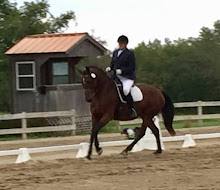In June of 2008 I was involved in a rescue operation that was so large that it involved three Wisconsin Rescues. Midwest Horse Welfare Foundation, St. Francis Rescue and Retirement and Refuge Farms. I had not done anything charitable for a while - so I decided to help. Well what a ride it turned out to be.
Hazel and Amore became permanent residents at Hay River Equestrian. Both horses were unhandled and unhaltered adult horses at the time of their adoption. This made it pretty hard to start. I decided both horses would have to be started with food as a bribe. I decided this because it would have been impossible to even try to halter them without grain. Both horses became gentle enough to be touched on their heads while eating and then eventually allowed halters to be slipped over their heads. They were so big and strong that they learned how to lead by following the grain. I would apply halter pressure and if they walked forward and released the pressure, they were allowed a bite of grain. I did it this way because I thought it would be safer than making them stand tied with no knowledge of how to release halter pressure.
They were both very smart and caught on fairly quickly.
Amore was less worried about being touched and allowed us to carefully start petting and touching him farther back on his body and then legs with very little trouble. Hazel was terrified of being touched and could be dangerous if you stood past her shoulder. So many hours went into touching her so she could understand that touch was not so bad. It took using fat soft ropes though to go around Hazel's hind leg so I could pick it up and stroke her leg safely. It took months for me to be able to pick out her hind feet. But it took a whole year before the farrier could trim her hind legs.
Both horses were with me for a year before they were ready to be trained to be riding horses. My friend Pam and I worked with them together until they would take saddles and learned basic lunging. Let me say that they were so scared at times that I had to be on full altert and very awake to be sure I did not get hurt while introducing them to new things. Amore was much more afraid of the saddle than Hazel. Hazel was scared of living things and Amore was afraid of inanimate things. This basic training was the most difficult time I have ever had with ground work. But when I say ground work, what I really mean is I had to change their reality of people and that is why it took so long.
Then I had a young trainer do the initial riding on them and in 2010 they were shown at horse shows. It was quite a reward to see them go to shows and act like well adjusted horses.
It does sadden me that there were 27 horses in this rescue in 2008 and to my knowledge only three of them are riding horses. The two here and one in Milwaukee WI. I now wonder with a 10% rehab rate into riding horses what could have been done differently? How can the rescues get a higher rehab rate? I think that most of these horses were basically healthy and had rehab potential. The biggest issue in my mind is rehab. The rescues do well at saving them - but then what?
Karen
Subscribe to:
Post Comments (Atom)

No comments:
Post a Comment
Note: Only a member of this blog may post a comment.